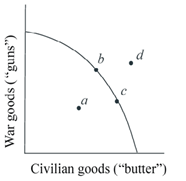Refer to the given production possibilities curve and give answer of following question . At the onset of the Second World War the Soviet Union was already at full employment. Its economic adjustment from peacetime to wartime can best be described by the movement from point: A) c to point b. B) b to point c. C) a to point b. D) c to point d.

Some one help me in getting out from above question